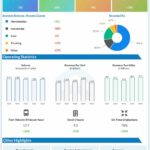
contrastaddict/iStock Unreleased via Getty Images
General Motors Company (NYSE:GM) and Ford Motor Company (NYSE:F) report earnings this week, and analysts are upbeat.
GM should report revenue of $42.36B and EPS of $1.83 on July 25. Ford (F), meanwhile, is expected to report revenue of $41.07B and EPS of $0.53 for the second quarter on July 27.
In April, General Motors (GM) said it beat on first-quarter expectations and raised its full-year EBIT-adjusted forecast to $11B to $13B from a prior view for $10.5B to $12.5B. The following month, Ford (F) said it beat earnings for the first quarter, though it issued a cautious full-year forecast.
The reports are coming after Tesla (TSLA) reported a drop in margins for Q2, prompting concern among investors about whether the back half of the year will see further weakness due to lower pricing and cost pressures. TSLA lowered prices during the quarter, and during the earnings call last week billionaire owner Elon Musk said the electric vehicle maker will cut prices again if economic conditions worsen.
But analysts cited strong pricing trends for both GM and F bolstering the companies.
“It seems volumes have held up in-line or better than expected globally thanks to strong consumer demand, requiring limited pricing action,” Deutsche Bank analysts led by Emmanuel Rosner wrote in a July 20 note.
The firm expects GM and F to beat Q2 expectations after speaking with executives recently. “GM and Ford (F) can both outperform Q2 consensus expectations, amid solid demand environment with resilient pricing dynamics so far this year.”
GM should outperform Street expectations despite truck plant downtime in the quarter supported by its $2bn cost reduction, Deutsche said. “We similarly expect Ford to beat in-going estimates amid the resilient pricing environment, led by strength in its Pro and Blue as Model e losses improve QoQ.”
Deutsche Bank said both GM and F have signaled that if current conditions hold, the full year guidance would likely be conservative, and the firm expects both carmakers to raise 2023 guidance.
There are, of course, union negotiations coming up, which could drive some uncertainty.
GM
Even though consensus estimates have risen, Citi sees “ample upside” from strong North America pricing for GM. Earlier in July, Citi rated the OEM a Buy and raised its price target to $89 from $85.
The automaker could preserve some cushion for macro and/or labor disruptions in the second half, Citi said, but “even with conservatism, GM likely exits 2023 at annualized EPS that’s well above ’23 consensus at the start of the year.” Additionally, GM is still under-earning by $4B to $5B this year considering Cruise losses, EV launch inefficiencies and certain ICE pricing gaps, Citi analysts Itay Michaeli and Justin Barell wrote in a July 12 note.
Meanwhile, Deutsche is especially excited about the automaker, expecting $3.5B in Ebita versus the consensus of $2.9B and EPS of $1.98 compared to the Street expectation of $1.68.
The firm noted that at a recent encounter, GM remained confident in its outlook for the year as consumer weakness has not yet shown through, with demand tracking “very well” so far this year. GM is also likely to hit the higher end of its 30% to 50% savings as guided earlier for 2023.
It’s not all rainbows, however.
“While pricing could serve as a source of upside to the year given the consumer resiliency we’ve seen so far in 1H, we think price pressure risk remains elevated into 2H and 2024,” Deutsche said.
Shares of GM are up nearly 15% year-to-date and have slipped since earlier this month.
FORD
Citi is slightly less positive on Ford (F), noting that consensus estimates have also risen for the automaker.
“We view the stock setup as slightly positive as another strong quarter should lead to upward estimate revisions and increased confidence in the company’s execution,” Citi said.
Citi, maintaining a Buy rating on F and upping its price target to $17 from $16, also sees some risk from potential second-half outlook conservatism.
The stock has shown strength of late, leading Citi to “see a somewhat better Q2 risk/reward setup for GM.” The firm still maintains a positive view on Ford.
Deutsche anticipates that Ford could raise its 2023 Ebit guidance to $10B to $12B and forecasts Ford’s Q2 Ebit of about $3.1bn, above the Street estimate of $2.9bn for the quarter, and EPS of $0.56, also above Street estimates $0.48.
Deutsche did acknowledge that pricing could soften.
“Given the resiliency thus far, we do think price pressure risk remains elevated into 2H and 2024. Should vehicle demand deteriorate from pressure on consumers or tighter lending standards, vehicle pricing would be the first lever pulled by the OEM,” the bank wrote.
On the EV front, things are less certain. On July 17, F said it would cut pricing of its Ford F-150 Lightning EV. BofA warned that the cut may “signal that incumbent OEMs may have to sacrifice pricing to compete in the EV market despite still-negative EBIT margins.”
BofA analysts led by John Murphy noted that TSLA’s aggressive price cuts have so far enabled it to maintain strong YoY growth and limit other OEMs from gaining meaningful market share,” though investors haven’t appreciated the decreases, driving TSLA’s share price lower after earnings were announced last week.
Also skeptical about F’s EV future was Seeking Alpha analyst David Alton Clark, who on July 20 he sold out of his F position after a “massive rally” on the stock. He also said “the road ahead for Ford’s electric vehicle aspirations is treacherous.”
“I have determined that with the recent run, all the good news may be priced in at this point,” Clark said.
The analyst said F is two EV generations behind Tesla (TSLA) and will “perpetually be behind the 8-ball if the don’t somehow catch up to Tesla (TSLA).”
With aggressive EV targets, “It’s a little too much to ask,” Clark wrote in a posting. “Odds are Ford is going to end up having to backtrack on some of their recent promises. This is why I decided to cash in on the remaining Ford position for a 24.45% gain.”
Shares of F are up nearly 26% year-to-date and have dropped in recent weeks.








